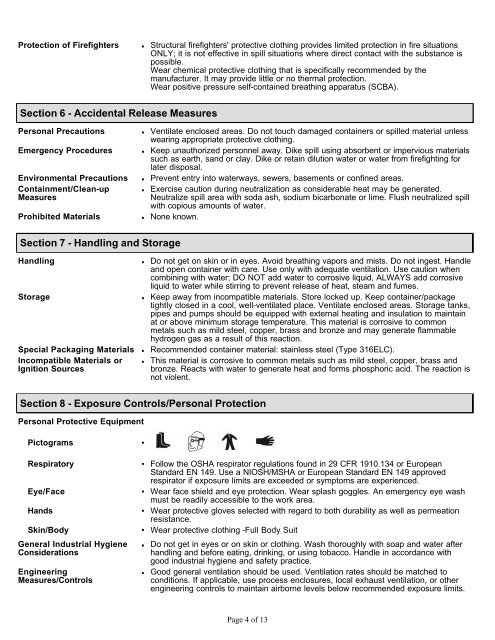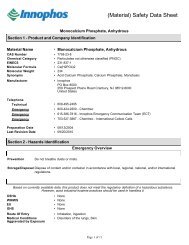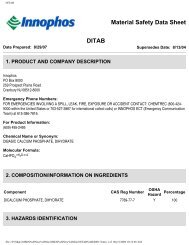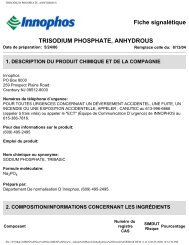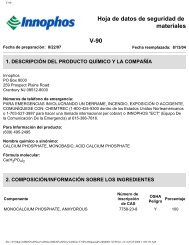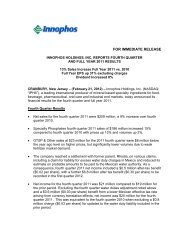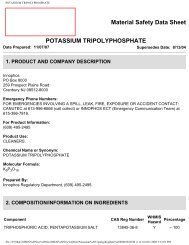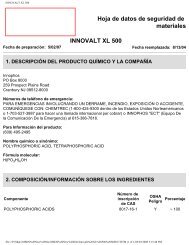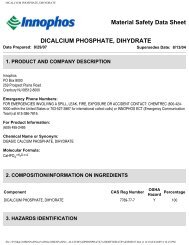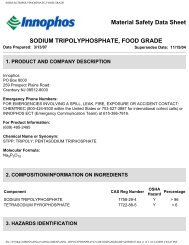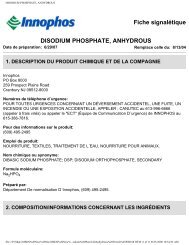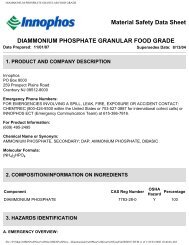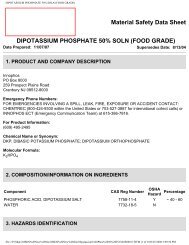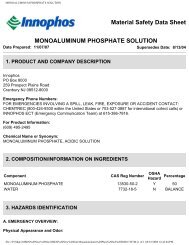Polyphosphoric Acid 105 to 118% - Innophos
Polyphosphoric Acid 105 to 118% - Innophos
Polyphosphoric Acid 105 to 118% - Innophos
Create successful ePaper yourself
Turn your PDF publications into a flip-book with our unique Google optimized e-Paper software.
Protection of Firefighters▪ Structural firefighters' protective clothing provides limited protection in fire situationsONLY; it is not effective in spill situations where direct contact with the substance ispossible.Wear chemical protective clothing that is specifically recommended by themanufacturer. It may provide little or no thermal protection.Wear positive pressure self-contained breathing apparatus (SCBA).Section 6 - Accidental Release MeasuresPersonal PrecautionsEmergency ProceduresEnvironmental PrecautionsContainment/Clean-upMeasuresProhibited Materials▪ Ventilate enclosed areas. Do not <strong>to</strong>uch damaged containers or spilled material unlesswearing appropriate protective clothing.▪ Keep unauthorized personnel away. Dike spill using absorbent or impervious materialssuch as earth, sand or clay. Dike or retain dilution water or water from firefighting forlater disposal.▪ Prevent entry in<strong>to</strong> waterways, sewers, basements or confined areas.▪ Exercise caution during neutralization as considerable heat may be generated.Neutralize spill area with soda ash, sodium bicarbonate or lime. Flush neutralized spillwith copious amounts of water.▪ None known.Section 7 - Handling and S<strong>to</strong>rageHandling▪ Do not get on skin or in eyes. Avoid breathing vapors and mists. Do not ingest. Handleand open container with care. Use only with adequate ventilation. Use caution whencombining with water; DO NOT add water <strong>to</strong> corrosive liquid, ALWAYS add corrosiveliquid <strong>to</strong> water while stirring <strong>to</strong> prevent release of heat, steam and fumes.S<strong>to</strong>rage▪ Keep away from incompatible materials. S<strong>to</strong>re locked up. Keep container/packagetightly closed in a cool, well-ventilated place. Ventilate enclosed areas. S<strong>to</strong>rage tanks,pipes and pumps should be equipped with external heating and insulation <strong>to</strong> maintainat or above minimum s<strong>to</strong>rage temperature. This material is corrosive <strong>to</strong> commonmetals such as mild steel, copper, brass and bronze and may generate flammablehydrogen gas as a result of this reaction.Special Packaging Materials ▪ Recommended container material: stainless steel (Type 316ELC).Incompatible Materials orIgnition Sources▪ This material is corrosive <strong>to</strong> common metals such as mild steel, copper, brass andbronze. Reacts with water <strong>to</strong> generate heat and forms phosphoric acid. The reaction isnot violent.Section 8 - Exposure Controls/Personal ProtectionPersonal Protective EquipmentPic<strong>to</strong>gramsRespira<strong>to</strong>ryEye/FaceHandsSkin/BodyGeneral Industrial HygieneConsiderationsEngineeringMeasures/Controls▪▪ Follow the OSHA respira<strong>to</strong>r regulations found in 29 CFR 1910.134 or EuropeanStandard EN 149. Use a NIOSH/MSHA or European Standard EN 149 approvedrespira<strong>to</strong>r if exposure limits are exceeded or symp<strong>to</strong>ms are experienced.▪ Wear face shield and eye protection. Wear splash goggles. An emergency eye washmust be readily accessible <strong>to</strong> the work area.▪ Wear protective gloves selected with regard <strong>to</strong> both durability as well as permeationresistance.▪ Wear protective clothing -Full Body Suit▪ Do not get in eyes or on skin or clothing. Wash thoroughly with soap and water afterhandling and before eating, drinking, or using <strong>to</strong>bacco. Handle in accordance withgood industrial hygiene and safety practice.▪ Good general ventilation should be used. Ventilation rates should be matched <strong>to</strong>conditions. If applicable, use process enclosures, local exhaust ventilation, or otherengineering controls <strong>to</strong> maintain airborne levels below recommended exposure limits.Page 4 of 13


